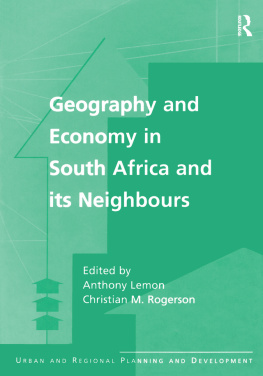Jayne M. Rogerson - New Directions in South African Tourism Geographies
Here you can read online Jayne M. Rogerson - New Directions in South African Tourism Geographies full text of the book (entire story) in english for free. Download pdf and epub, get meaning, cover and reviews about this ebook. year: 2020, publisher: Springer International Publishing, genre: Politics. Description of the work, (preface) as well as reviews are available. Best literature library LitArk.com created for fans of good reading and offers a wide selection of genres:
Romance novel
Science fiction
Adventure
Detective
Science
History
Home and family
Prose
Art
Politics
Computer
Non-fiction
Religion
Business
Children
Humor
Choose a favorite category and find really read worthwhile books. Enjoy immersion in the world of imagination, feel the emotions of the characters or learn something new for yourself, make an fascinating discovery.
- Book:New Directions in South African Tourism Geographies
- Author:
- Publisher:Springer International Publishing
- Genre:
- Year:2020
- Rating:5 / 5
- Favourites:Add to favourites
- Your mark:
- 100
- 1
- 2
- 3
- 4
- 5
New Directions in South African Tourism Geographies: summary, description and annotation
We offer to read an annotation, description, summary or preface (depends on what the author of the book "New Directions in South African Tourism Geographies" wrote himself). If you haven't found the necessary information about the book — write in the comments, we will try to find it.
New Directions in South African Tourism Geographies — read online for free the complete book (whole text) full work
Below is the text of the book, divided by pages. System saving the place of the last page read, allows you to conveniently read the book "New Directions in South African Tourism Geographies" online for free, without having to search again every time where you left off. Put a bookmark, and you can go to the page where you finished reading at any time.
Font size:
Interval:
Bookmark:

In a geographical tradition and using an integrated approach this book series addresses these issues by acknowledging the interrelationship of tourism to wider processes within society and environment. This is done at local, regional, national, and global scales demonstrating links between these scales as well as outcomes of global change for individuals, communities, and societies. Local and regional factors will also be considered as mediators of global change in tourism geographies affecting communities and environments. Thus Geographies of Tourism and Global Change applies a truly global perspective highlighting development in different parts of the world and acknowledges tourism as a formative cause for societal and environmental change in an increasingly interconnected world.
The scope of the series is broad and preference will be given to crisp and highly impactful work. Authors and Editors of monographs and edited volumes, from across the globe are welcome to submit proposals. The series insists on a thorough and scholarly perspective, in addition authors are encouraged to consider practical relevance and matters of subject specific importance. All titles are thoroughly reviewed prior to acceptance and publication, ensuring a respectable and high quality collection of publications.
More information about this series at http://www.springer.com/series/15123

This Springer imprint is published by the registered company Springer Nature Switzerland AG
The registered company address is: Gewerbestrasse 11, 6330 Cham, Switzerland
The central theme for geographers is interpreting and understanding the natural and human-made environmenta world in which geographic patterns are constantly being reworked by a diverse array of factors (Gill 2012; Butler 2015; Mller 2019; Saarinen 2019). These various influences include population changes, new patterns of economic production and consumption, evolving social and political structures, new forms of urbanism, globalisation and the compression of time and space that are the product of ongoing revolutions in information technology and telecommunications. Significantly influencing these processes, tourism has also become a force for change as an integral and indispensable part of the places and space in which we live (Williams and Lew 2015). In short, the tourism system has a reach that very few are isolated from and leads to changes in the manner in which rural and urban places and spaces are (re)constructed in a multitude of ways. Annually billions of domestic and international tourists temporally migrate across the world and present a fundamental geographic phenomenon social scientists and planners cannot ignore as it has become an essential way in which humans engage with one another and environments. The reason why understanding tourism calls for our attention is located in the sheer scale of contemporary tourism and the pace at which it has expanded.
Tourism has become a key component of the South African economy and impacts in various ways the lives of millions of the countrys citizens in both rural and urban settings. Tourism geographies matter to South Africas spatialities has been the underlying mantra and is important because it touches millions of livelihoods, directly and indirectly. Over the past two decades, geographers described and analysed the South African tourism system as well as assessed its potential for achieving the policy objectives set by the national government. Several research clusters emerged in terms of the changed post-1994 policy environment in South African tourism. These were explored in terms of the overarching themes of (1) studying the responses to and impacts of government intervention and of the shifting policy environment; (2) analysing a set of threats to the development of tourism in South Africa; and (3) demonstrating the sectors important role as an economic driver of the post-apartheid economy. It was argued that in the international context, one of the most distinguishing aspects of the South African national tourism policy frameworks was the strong commitment towards tourism assuming a developmental role at various scales. More particularly, the tourism geographies of the late 1990s and early 2000s placed major emphasis upon employment creation and enterprise development in support of the countrys previously neglected communities. Among these objectives were strategies to develop niche markets in South Africa that would not only be globally competitive but would also provide opportunities for inclusion of communities disadvantaged under apartheid.
The period 19942015 can be seen, in many respects, as a first phase in post-apartheid tourism geography. A major review of work in this first phase was provided by Visser (2016). The collection of research essays in this book builds on this investigatory tradition. It presents new insights into the most recent research findings by a range of scholars on a number of different topics at the cutting edge of debates in local tourism geographical scholarship. The volume presents 18 selected chapters which together provide a window on new directions occurring in tourism geographical research in South Africa. This said, the collection cannot be seen as exhaustive as there are many other issues that remain to be explored.
Font size:
Interval:
Bookmark:
Similar books «New Directions in South African Tourism Geographies»
Look at similar books to New Directions in South African Tourism Geographies. We have selected literature similar in name and meaning in the hope of providing readers with more options to find new, interesting, not yet read works.
Discussion, reviews of the book New Directions in South African Tourism Geographies and just readers' own opinions. Leave your comments, write what you think about the work, its meaning or the main characters. Specify what exactly you liked and what you didn't like, and why you think so.








